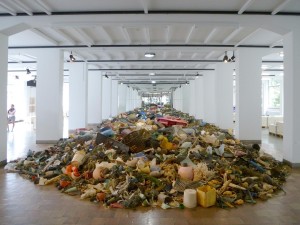This picture is from the exhibit “Out to Sea – The Plastic Garbage Project” from the Zurich Museum of Design in Switzerland. It shows how much garbage ends up in the oceans every fifteen seconds.
A lot of this garbage is accidental. It’s stuff that got blown away or swept up in a storm. But most of it isn’t really accidental. It’s plastic water bottles that people left on the beach. It’s balloons that people release because they think it’s a nice tribute to someone (it isn’t, it’s just pollution). It’s waste materials from ships.
It’s all a problem.
But plastic pollution is probably the worst. It’s estimated that plastic pollution kills about one million sea animals every year. Animals can get tangled in plastic bags and suffocate. Or they can mistake plastic bags for jellyfish. If they try to eat the plastic bag, they can choke or get an intestinal blockage. It’s estimated that plastic bags kill 100,000 animals a year that way. Another problem is nurdles. Nurdles are tiny plastic beads. They often end up in the ocean where they resemble fish eggs. Animals eat the nurdles but can’t digest them. As their stomach fills with nurdles, the animal becomes unable to eat and pass real food. And they die of starvation.
So what can you do?
- Never take a plastic shopping bag at the grocery store. Bring your own reusable bags instead.
- Make sure you don’t leave any trash behind when you visit the beach.
- Cut down on how much garbage you make. Recycle. Buy things that don’t have a lot of wrappers and packaging that will just get thrown away.
- Don’t buy soaps that have those little plastic exfoliating beads.
- Buy non-toxic soaps, shampoos, and cleaners.
Sources:
http://www.environment911.org/The_Effects_of_Ocean_Dumping
http://www.ryot.org/microbeads-impact-environment-micro/361757
